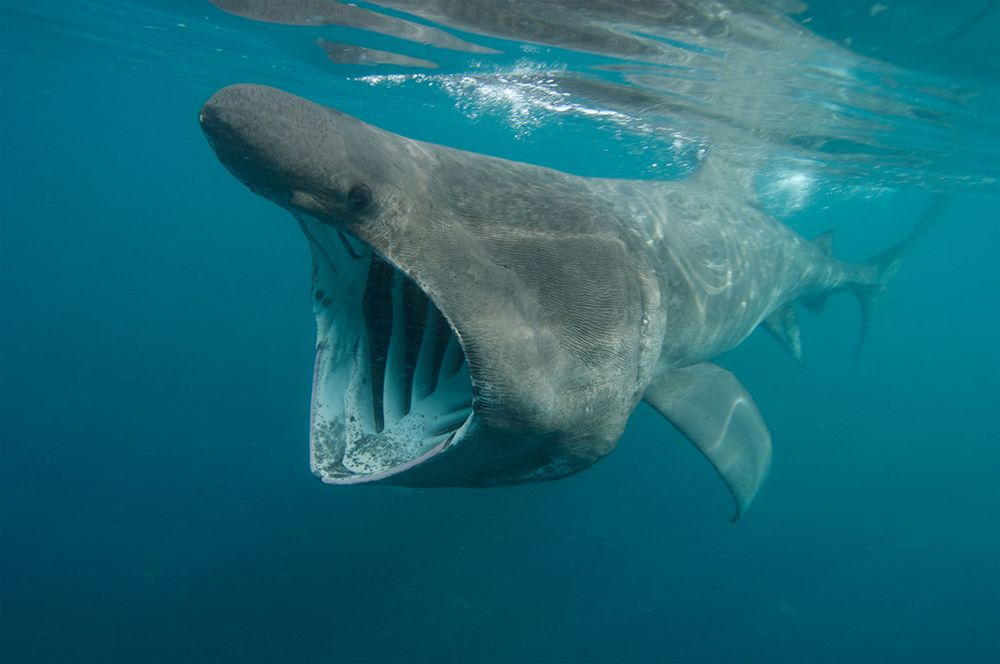
The waters around the British Isles are an amazingly rich and diverse marine habitat where you can encounter creatures that you will simply never find on a tropical reef, often in water as clear and calm as the Red Sea (albeit a little cooler).
Britain’s ancient maritime history– both glorious and tragic – is unparalleled around the world, much of it preserved beneath the waves around and therefore only accessible to divers.
The UK and Ireland are home to some truly amazing, awe-inspiring, world-class diving, so it’s time to explore the world of drysuits, bacon butties and traditionally brewed, full-flavoured post-dive deco beers – here are ten top dive spots around the UK and Republic of Ireland that you might like to try.
FALMOUTH – CORNWALL

Falmouth Bay is a favourite among British divers for the range of options that if offers to divers of all experience levels, from easy shore diving to deeper technical wrecks. The very nature of the location means that there are plenty of ships to explore, many of them easily accessible even to entry-level divers – diving straight from the beach will put you within reach of the remains of U-boats from the First World War. A boat ride along the coast will bring you to the Manacles, one of the most treacherous reefs in the world in terms of ships wrecked and lives lost, but also one of the most beautiful; steep walls and shallow gullies blanketed with soft coral and anemones, and one of Falmouth’s most famous wrecks, the SS Mohegan. Cornwall as a whole offers plenty of excellent diving – and is a hotspot for basking sharks, for which trips can be arranged – but Falmouth, with its broad range of options, makes it an ideal place to start your discovery.
SWANAGE – DORSET

Swanage Bay provides some of the easiest diving around the southern UK coastline. Sheltered from the elements and prevailing currents and therefore making it dive-able throughout the tidal range, the shallow sea around Swanage Pier is a popular spot for both entry-level training and more experienced divers who want to see interesting things in relaxed, calm waters. During the summer months, an outstanding variety of marine life can be encountered, with plenty of crabs, cuttlefish, squid and the famous tompot blennies scuttling about underneath the pier. Heading out of the bay means that diving is more dependent on the tides, affording divers the opportunity to drift across the Peveril Ledges looking for lobster, and further out to sea for advanced divers is the wreck of the SS Kyarra, a 126m-long former passenger liner converted into a hospital ship during WW1 and sunk by a German u-boat in 1918.

FARNE ISLANDS – NORTHUMBERLAND
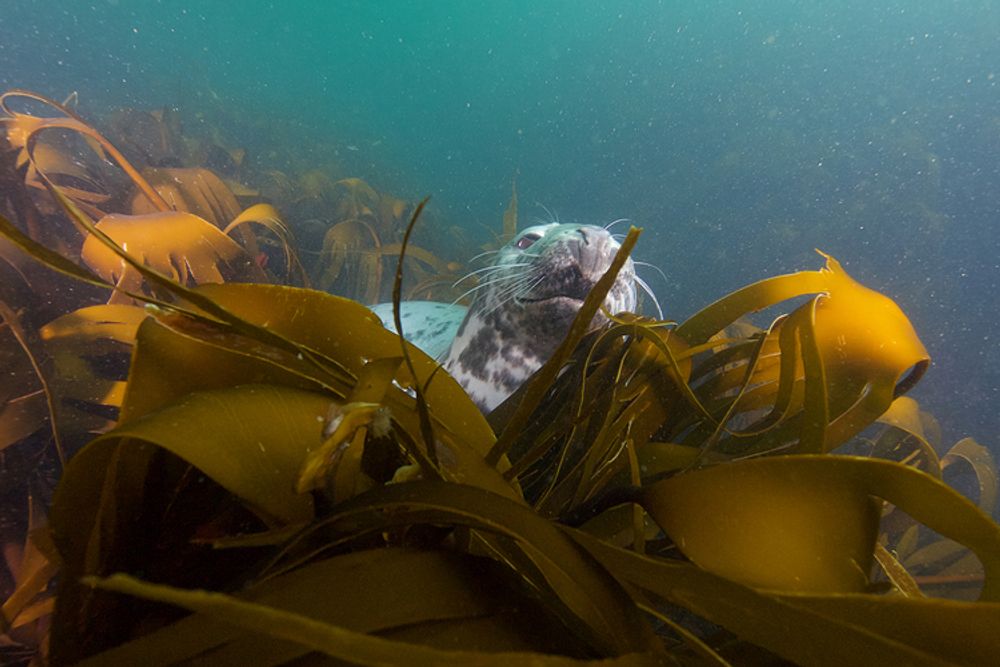
A collection of small islands located a few miles from the coast, the Farne Islands’ most famous attraction is the largest colony of grey seals to be found around the UK’s coastline. Fully grown, adult bulls can reach well over 2.5m in length and weigh over 300kgs, making their close – but harmless – inspections a fairly heart-stopping encounter, but the greatest delight for divers is no doubt the young pups – friendly, inquisitive, renowned for their underwater acrobatics and playfully nibbling on your fins! As with most UK dive locations, there are plenty of wrecks – the most popular of which being Somali, a cargo ship sunk by the Germans in 1941 carrying – among other things – a huge cargo of lead toy soldiers and much of which, including the armaments and massive engine, remains intact for exploration. The islands are home to a number of nesting bird species, including one of everybody’s favourites – the puffin.
LUNDY – DEVON

Another popular place for diving with seals is the island of Lundy, located in the mouth of the Bristol Channel about 12 miles north of the Devon coast. Described as having some of the clearest waters around the British coast, it was one of the first locations in the UK to be designated is a marine protected area. According to the Landmark Trust, the action of the Gulf Stream makes the area one of the richest marine environments outside of the tropics. According to their website, ‘2,500 different creatures can be found in a single square metre of seabed and it is the only place where all five types of British cup coral can be found’. The seal population is much smaller than the Farne Islands, but equally delightful interactions are commonplace. As the island is prone to very strong tidal currents, diving around Lundy is not for the novice, but is otherwise described as a spectacular location for those with experience and knowledge.
ISLES OF SCILLY
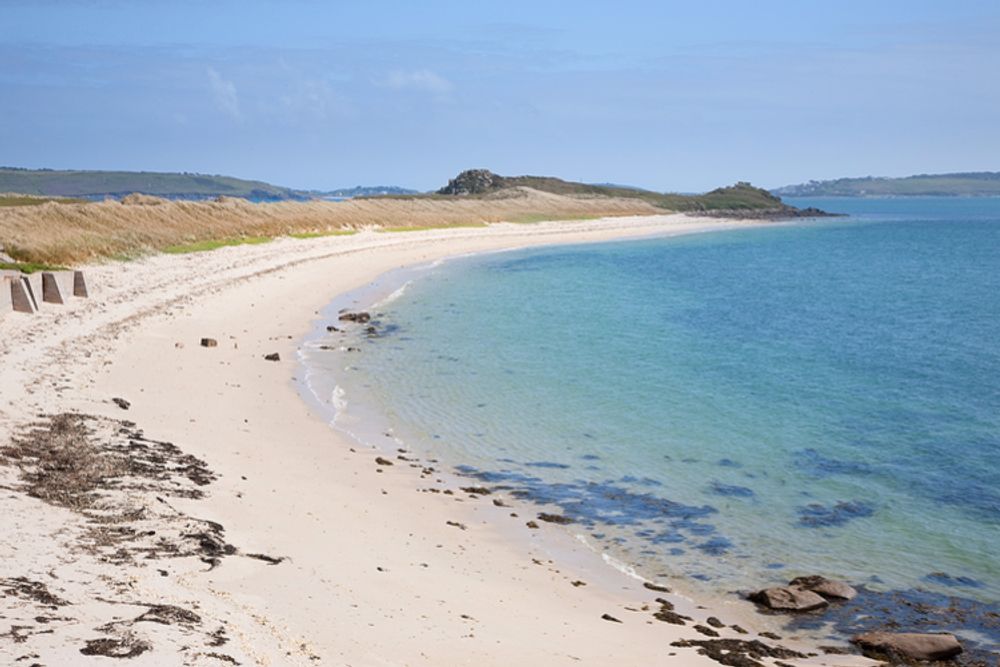
Technically part of Cornwall, the archipelago known as the Isles of Scilly is the most southerly part of the United Kingdom, some 28 miles south-west of Land’s End. Designated as an Area of Outstanding Natural Beauty, the remote location and extremely mild climate – thanks again to the Gulf Stream – has led to the Isles being described as a sub-tropical paradise, and just a few miles of the British shore! The waters remain cool, however, so drysuits are recommended, but the crystal clear water and vibrant, coral-encrusted reefs make up for the inconvenience. As to be expected around a chain of 150 small islands and jagged rocks, hundreds of ships have been wrecked in the surrounding water, from the historical to the more modern wreck of the 30,000 ton Cita (1997), with the Plympton, an early 20th century wreck and Hathor – which managed to sink on top of her – being among the most popular. And also seals!
ISLE OF MAN

Lying halfway between mainland Britain and Ireland, the Isle of Man is probably better known around the world for the famous motorcycle road race. What a lot of people don’t know, however, is that it is also home to some outstanding diving. From May until August, it is one of the best places to encounter basking sharks – the world’s second largest fish after the whale shark, and also a filter-feeder, unlike its predatory cousin, the great white. Other hotspots include Cornwall and the Hebrides (Scotland), but – at least according to the Isle of Man tourism website – it is often the case that more are reported in Manx waters than elsewhere around the British Isles. One of the most well-regarded dive spots is the Burroo, where strong tidal currents restrict diving to slack tide only, but the same currents bring some of the richest and most diverse collection of marine life to the Island. The Sugarloaf Caves provide an entirely different experience, suitable even for the relative novice as most of the system allows you to surface inside, and where seals will accompany you along the way. Local wrecks include the easy and shallow Citrine, or the deeper SS Liverpool, which still contains a collection of unbroken china plates in its hold.
COUNTY DONEGAL – REPUBLIC OF IRELAND
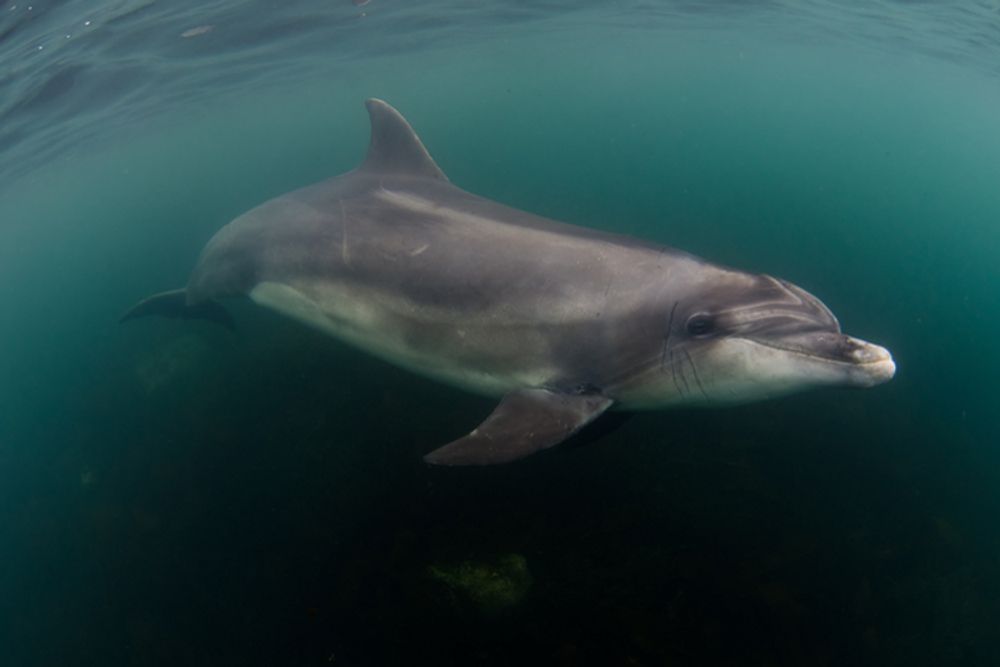
Located on the North West coast of the Republic of Ireland, Donegal is a name that many people will recognise, but probably not associate with diving. Nevertheless, Malin Head, the most northerly point of the Irish island, is also listed by the Shark Trust as a hotspot for basking sharks. It’s also one of the few places in around the UK and Ireland where mola-mola, the oceanic sunfish, can be sighted. The wreck of the Laurentic is easily accessible, and although most of her cargo of gold bullion was recovered after she sank, local reports suggest that up to 20 bars may still be missing. Marine life is always plentiful and along with the usual crustacean suspects, conger eels and schooling pollock are regular visitors and the occasional bottlenose dolphin can be seen. Deep wreck enthusiasts may want to look into tech-diving the WW1 Dreadnought HMS Audacious, or the SS Empire Heritage and her cargo of Sherman tanks. From novice to experienced, wildlife to wrecks, County Donegal and its extensive, craggy coastline has a great deal to offer.
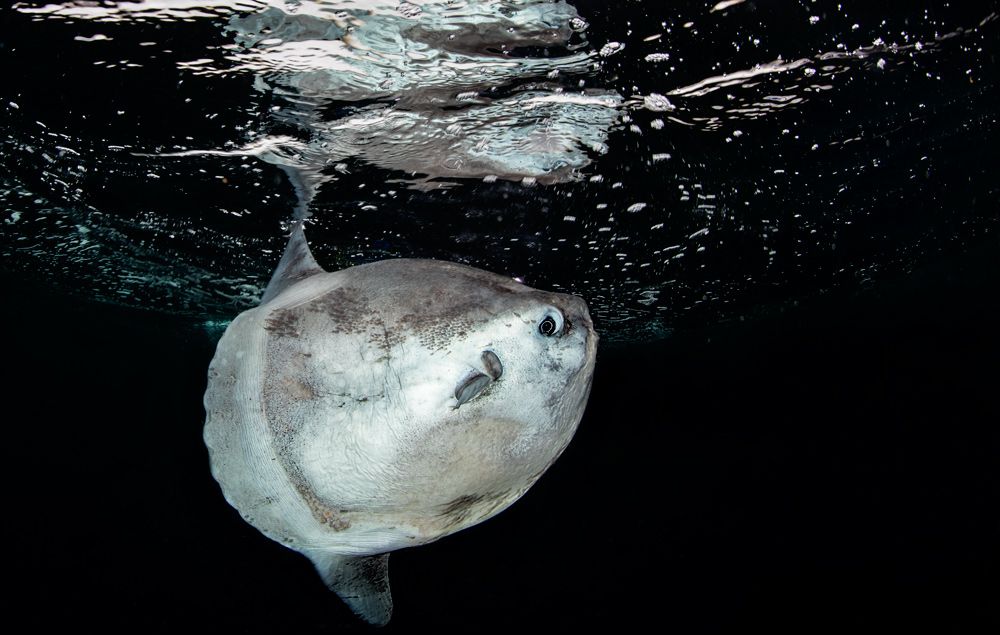
SCAPA FLOW – ORKNEY, SCOTLAND
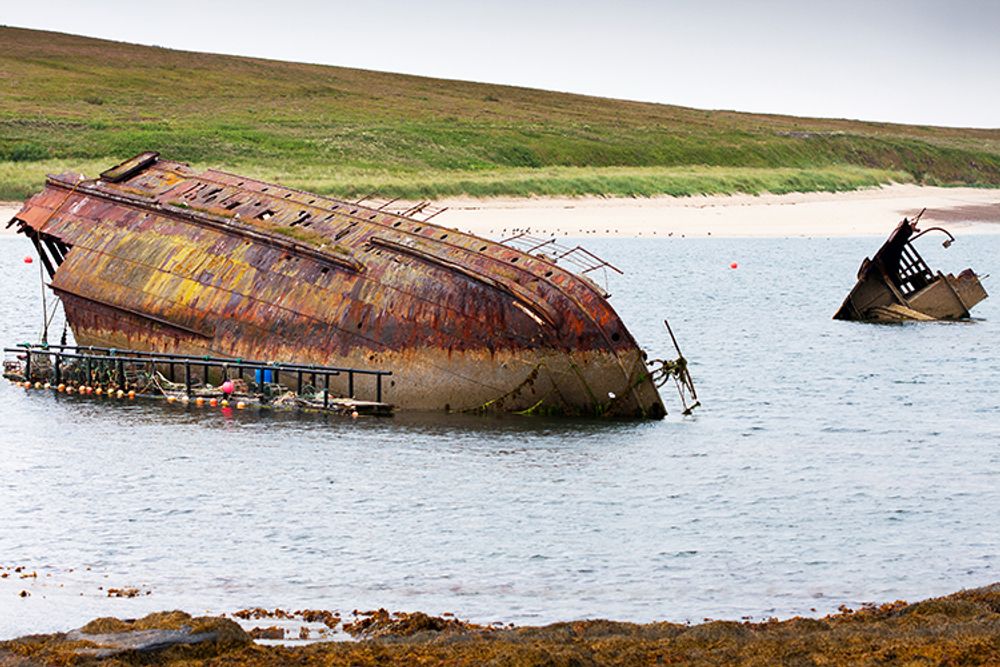
Probably the UK’s most famous dive site, and on many divers’ bucket lists, the wreck dives of the Scapa flow off the far north-eastern coast of Scotland are classed by many as the best wreck diving experience in the world. On 21 June 1919, the German navy scuttled 74 of their own ships that were held captive by the British Navy. Of those, 52 sank, 45 of which were later salvaged. The remaining seven vessels and the ‘blockships’ deliberately sunk by the Royal Navy in an attempt to prevent attacks from u-boats form the core of the Scapa wreck diving experience; relatively shallow and often with very little current, the wrecks are easily accessible by divers of all experience levels. There are many more wrecks in the area from older sailing ships to modern fishing vessels – along with a plethora of interesting wildlife – but the most talked about, and the most dived, are the eerie remains of the German High Seas Fleet.
ST KILDA – OUTER HEBRIDES, SCOTLAND
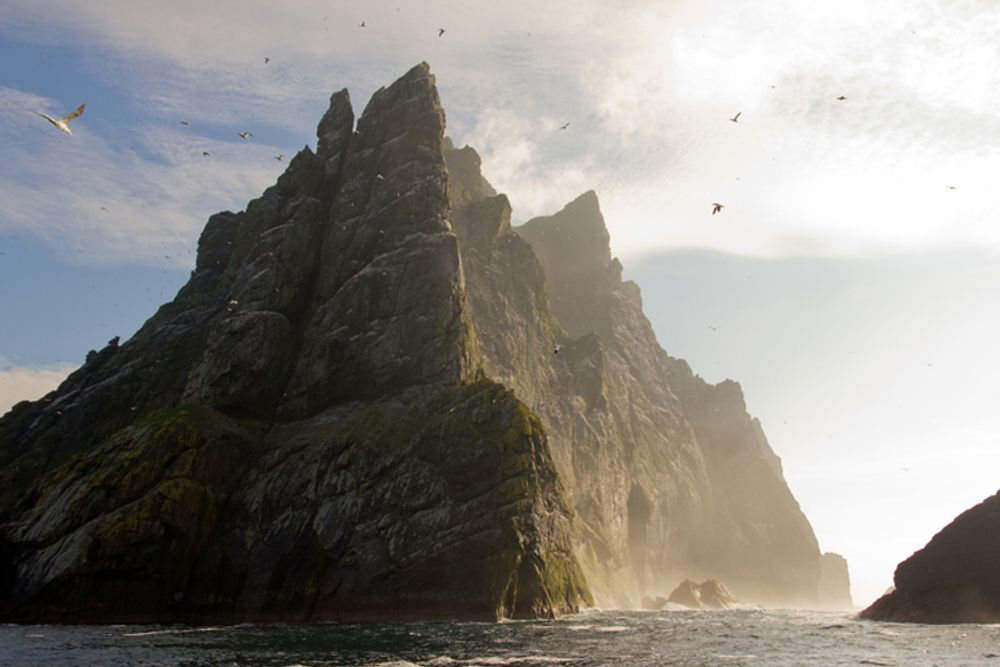
St Kilda is one of the most remote and isolated parts of the UK – some 40 miles from the main islands of the Outer Hebrides and 100 miles from the Scottish mainland. A volcanic archipelago comprising of four main islands and a number of sea stacks, the area is home to a fantastic collection of underwater architecture, tunnels, caves and cracks formed by volcanic activity and now teeming with life. Crystal clear blue water populated with dense kelp forests provides a home to an abundance of small crustaceans, and the nooks and crannies in the rock formations are home to some very large lobster. Seals and basking sharks are frequent visitors and there are minke whales in the region, although not commonly encountered whilst diving – sightings of dolphins and even the occasional orca during the voyage out to the islands have been reported. The area is prone to high seas, strong currents and harsh weather so just getting there is likely to be an adventure all by itself, but for those that have braved the elements to dive there, St Kilda has left a special place in their memories.
ANGLESEY – WALES
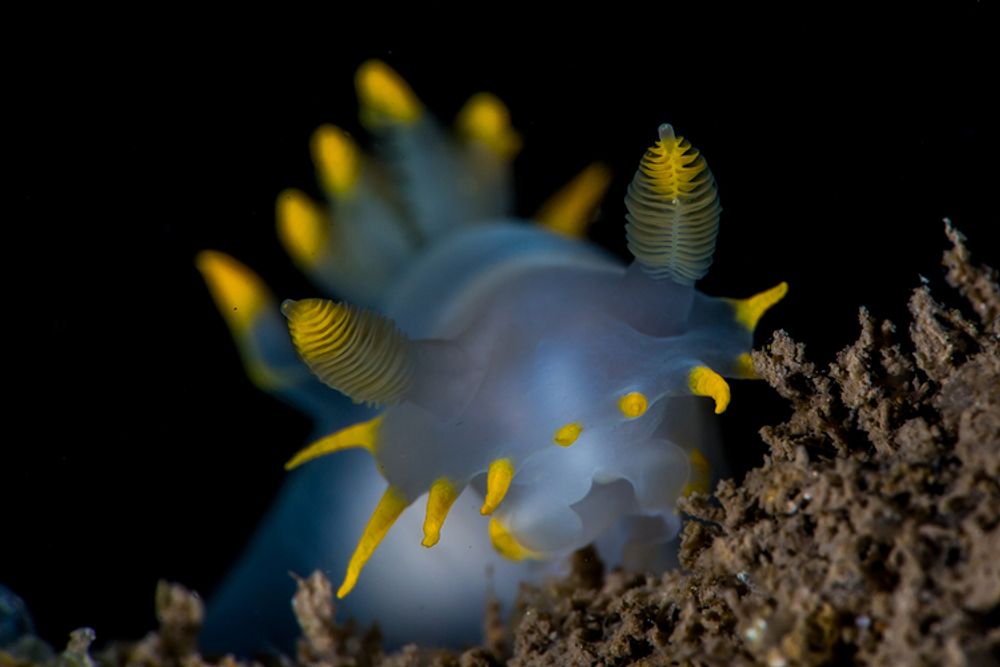
Wales has a long and very unspoilt coastline and, like much of the western coast, is heavily influenced by the Gulf Stream. Warm currents from the equator meet the cold run-off from the Atlantic through the North and Irish seas, creating a habitat as rich in wildlife as many others around the UK, and, needless to say, plenty of currents, rocks and reefs where thousands of ships have met their doom.
Anglesey, just off the north-west coast of Wales and easily accessible by road via the bridge over the very narrow Menai Straits, has a good collection of both. Much of the diving can be conducted from shore, and most of the dive sites are relatively shallow, averaging about 20 metres as a maximum. Plenty of marine life including lobster, nudibranchs, octopus and conger eels can be found there.
According to the Anglesey website, there are more than 400 wrecks along the coast, however not all are accessible. Some notable dives include the SS Missouri, resting in only 15m of sheltered water making it an ideal first wreck dive, and the remains of a B-17 bomber at North Stack, accessible by boat from Holyhead. The area is very tidal and strong currents are common, however there are plenty of sheltered sites if conditions turn unfavourable.
AND FINALLY – STONEY COVE
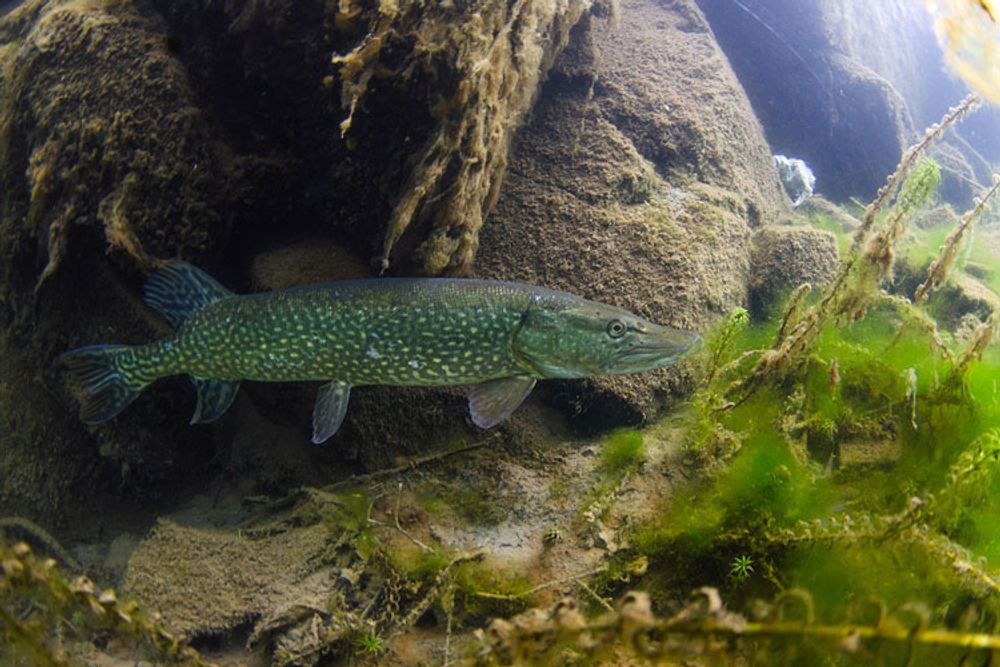
One of the best dive sites in the UK? Debatable. One of the most interesting, accessible and fun dive sites on the planet? Definitely! After all, where else are you going to find a bus, a helicopter, a tank, several shipwrecks, some cars, aircraft and a genuine relative of the Loch Ness Monster sitting happily in a placid lake in a disused quarry with pike, perch and crayfish quietly observing your every move? There’s a cracking pub, there are bacon butties, and it’s pretty much slap-bang in the middle of England, not far from the M1. With a maximum depth of around 36m, Stoney Cove has something for everyone – from the absolute beginner to the serious techie; even those strange people who don’t want to get into the water at all. Diving doesn’t have to be about trekking to the ends of the Earth and back to find that one elusive critter in order to make that perfect photo. It’s about being underwater and enjoying yourself, and all over the UK, it’s right there on your doorstep, if you want it.
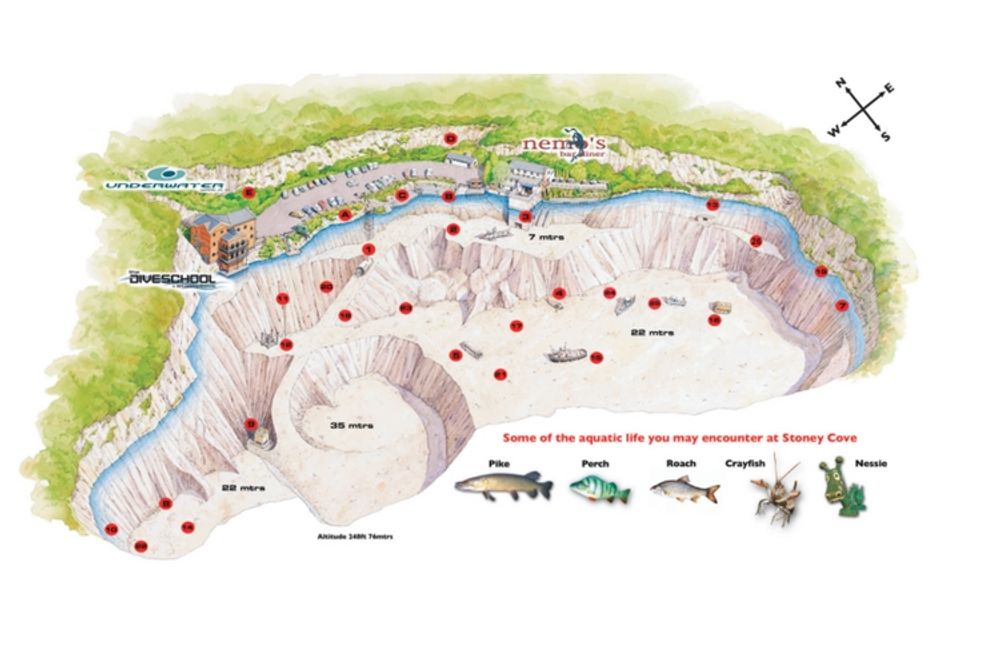
Map of Stoney Cove – see www.stoneycove.com


